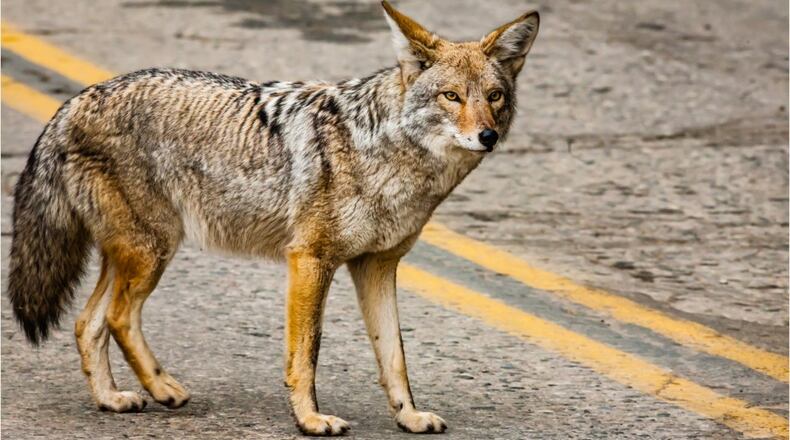Fairfield has invited Wildlife Management Supervisor Brett Beatty from the Ohio Department of Natural Resources (ODNR) to share effective methods for alleviating the problem through programs to reduce the population within the city and how to protect household pets.
After the meeting, City Council may consider alternatives recommended by Beatty, according to the letter.
Two weeks ago, residents of the subdivision east of Winton Road and north of Resor Road voiced concerns about increased activities of coyotes in their neighborhood. Liz Jarvis, of Clara Bea Lane, said two residents in that neighborhood had coyotes attack and kill their pets.
One attack was on Monica Drive and one was on Hallmark Court, she said.
“I think they qualify as far as the animals that are running loose,” said Jarvis, “that are threatening our safety as neighbors as well as our pets.”
She submitted the 60-resident petition to City Council, asking the body to do something.
“We ask the council to direct the appropriate department to review this issue, regarding the safety of our residents and their pets and develop a plan of action for now and in the future,” she said. “I am sorry that it took two families to lose their pets before the neighbors are requesting action from the council.”
Monica Drive resident Jessica Jefferies said she had concerns because she has two young children and walks her first-grader to the bus stop, which is just three houses down from their home.
“He should be able to walk three houses by himself ... but I don’t let him,” she said. “He’s 45 pounds. A coyote could be out and take my child.”
Recently, she said her son saw coyotes chase her next-door neighbor’s dog “and now he’s petrified to go outside.”
“It’s not just dogs we’re concerned about, it’s our children of the neighborhood,” she said.
Councilwoman Leslie Besl said, after Jarvis and Jefferies spoke, they’ll try to stream the Jan. 9 meeting, and the goal is to “try to find some resolution to this.”
“We are listening,” she said at the Nov. 14 meeting. “We do see what you say, and we’re sometimes limited on what we can do, but I wanted you to know it’s not falling on deaf ears.”
According to the ODNR, coyotes are primarily active during nighttime hours, but when it’s not threatened by human beings, they have been known to hunt and prowl during the day. Coyotes are omnivorous animals and food sources typically include small mammals and carrion, as well as vegetables and nuts. They have been known to eat livestock, like chickens, as well as small pets.
“The coyote’s strength is that it can adapt and exploit most any habitat to its advantage,” according to the ODNR. “While most wildlife species have avoided developed areas and often declined as a result of man’s expansion, the coyote seems to have thrived.”
Jefferies said the two animal attacks happened just a few houses from her son’s bus stop.
“The coyotes are very, very active in this area,” she said. “It’s a huge concern.”
Mayor Mitch Rhodus and Councilmember Gwen Brill live in the same neighborhood and say they hear them most every night.
The mayor said he and his wife, Lois, walk their dog at night and use a flashlight and carry a homemade noise maker (a can with coins) if they see a coyote.
Brill lives behind one of the two residents that lost their dog, saying the coyotes came over that neighbor’s fence. She’s concerned for her two dogs as well.
“I have a small fenced-in area for my two Yorkies, and I don’t let them out without me being out there, which I’m not sure I could defend them very well,” she said.
She said her home’s security cameras capture coyote activity “almost every night,” including at least two or three coyotes in our yard.
“It is a problem,” she said.
What to do if a coyote is in your backyard
Coyotes are common throughout Ohio, in both rural and urban settings. And there are no wild wolves living in the state.
The Ohio Department of Natural Resources says it’s first important to identify whether the animal is a coyote and not a stray dog. If you determine that the animal is a stray dog ― coyotes are slender and very similar in appearance to a medium-sized dog, but has a bushy tail usually tipped in black, and the majority of are gray, though some show a rusty, brown, or off-white coloration ― contact your county dog warden.
If a coyote is coming onto your property, it’s advised to remove all attractants to possibly deter the coyote from returning. This includes removing garbage and pet food before nightfall and cleaning around the grill. Coyotes prey primarily on small mammals, such as rabbits and mice, and small pets may also be taken. Keep small dogs and cats inside or stay with them at night when coyotes are most active.
Coyotes are curious, but they’re generally fearful of humans. Clap your hands and shout to scare off coyotes that are investigating your yard.
If a visiting coyote seems to lack a fear of humans or is presenting a conflict even after removing attractants from your yard, the Ohio Department of Natural Resources advises contacting a nuisance trapper. Nearby trappers can be located by calling the Division of Wildlife at 1-800-WILDLIFE (945-3543).
Go to www.wildohio.com to view more information online.
SOURCE: The Ohio Department of Natural Resources
About the Author

